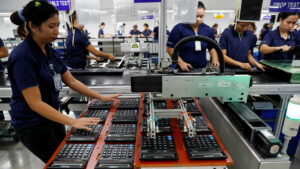FOREIGN INVESTMENT pledges received by Philippine investment promotion agencies (IPA) surged in the third quarter, driven by investments from South Korea and Switzerland, the statistics agency reported.
Preliminary data from the Philippine Statistics Authority (PSA) showed the value of foreign commitments approved by IPAs soared by 434.4% year on year to P146.75 billion in the July-to-September period from P27.46 billion in the third quarter of 2023.
Despite the strong annual growth, the amount was the lowest in investment commitments since the third quarter of 2023.
Quarter on quarter, it also slid by 22.56% from P189.5 billion in the second quarter.
South Korea was the top source of foreign investment pledges in the third quarter with P53.72 billion (36.6%), followed by Switzerland with P51.84 billion (35.3%). Investment commitments from Japan stood at P15.96 billion (10.9%).
The PSA compiles investment pledges approved by the government’s six IPAs: Board of Investments (BoI), BoI-Bangsamoro Autonomous Region in Muslim Mindanao (BoI-BARMM), Clark Development Corp. (CDC), Cagayan Economic Zone Authority (CEZA), Philippine Economic Zone Authority (PEZA), and Subic Bay Metropolitan Authority (SBMA).
The BoI approved P70.34 billion in foreign investment pledges, accounting for 47.93% of this quarter’s total.
PEZA approved P58.38 billion worth of foreign investment pledges, which accounted for 39.78% of the total. This was followed by CDC with P14.66 billion, BoI-BARMM with P86.7 million, SBMA with P53 million, and CEZA with P3.24 million.
The Calabarzon Region accounted for 40.1% of the pledged foreign investments with P58.86 billion. This was followed by the Bicol Region with P51.84 billion and Central Luzon with P15.2 billion.
The manufacturing industry received nearly half of approved pledges with P70.57 billion, followed by electricity, gas, steam, and air-conditioning supply industry with P51.92 billion and real estate activities with P13.13 billion.
Foundation for Economic Freedom President Calixto V. Chikiamco said in a Viber message that the growth in foreign investment pledges could be attributed to the liberalization of investment laws, such as the amendments to the Public Service Act.
“Aside from reducing the cost of doing business with better infrastructure and less red tape, the government can further spur foreign investments by further liberalizing our restrictive anti-FDI laws, primarily the Constitution,” he said.
First Metro Investment Corp. Head of Research Cristina S. Ulang said the higher investment pledges reflect President Ferdinand R. Marcos, Jr.’s “untiring global investment promotion” for the country.
The Department of Trade and Industry reported in June that a total of $19 billion worth of investments pledged during Mr. Marcos’ foreign trips have been actualized or implemented.
She also noted the newly signed Corporate Recovery and Tax Incentives for Enterprises to Maximize Opportunities for Reinvigorating the Economy (CREATE MORE) law could help attract foreign investments.
CREATE MORE expands incentives and lowers corporate income tax on businesses registered with IPAs.
“Very sustainable given the more competitive fiscal incentives and greater emphasis for ease of doing business in the country,” Ms. Ulang said in a Viber Message to BusinessWorld.
Mr. Chikiamco said he expects more investments from South Korea once the free trade agreement (FTA) takes effect.
The Senate in September ratified the FTA between the Philippines and South Korea, which will remove Philippine tariffs on 96.5% of goods from South Korea, while Seoul will lift tariffs on around 94.8% of Philippine products.
However, the FTA is still undergoing the ratification process at the Korean National Assembly.
Mr. Chikiamco said the government needs to forge more free trade deals with the European Union, Canada, and the United Arab Emirates.
“Short of any negative geopolitical event, this momentum of increased foreign investments will probably be sustained,” he added.
PSA data also showed investment pledges of foreign and Filipino nationals surged by 542% to P541.29 billion in the third quarter. Of this, Filipino nationals pledged P394.54 billion in investments.
PSA data on foreign investment commitments, which may materialize in the near future, differ from actual foreign direct investments tracked by the Bangko Sentral ng Pilipinas for the balance of payments. The central bank’s monitoring goes beyond the projects and includes other items such as reinvested earnings and lending to Philippine units via their debt instruments. — Aubrey Rose A. Inosante

